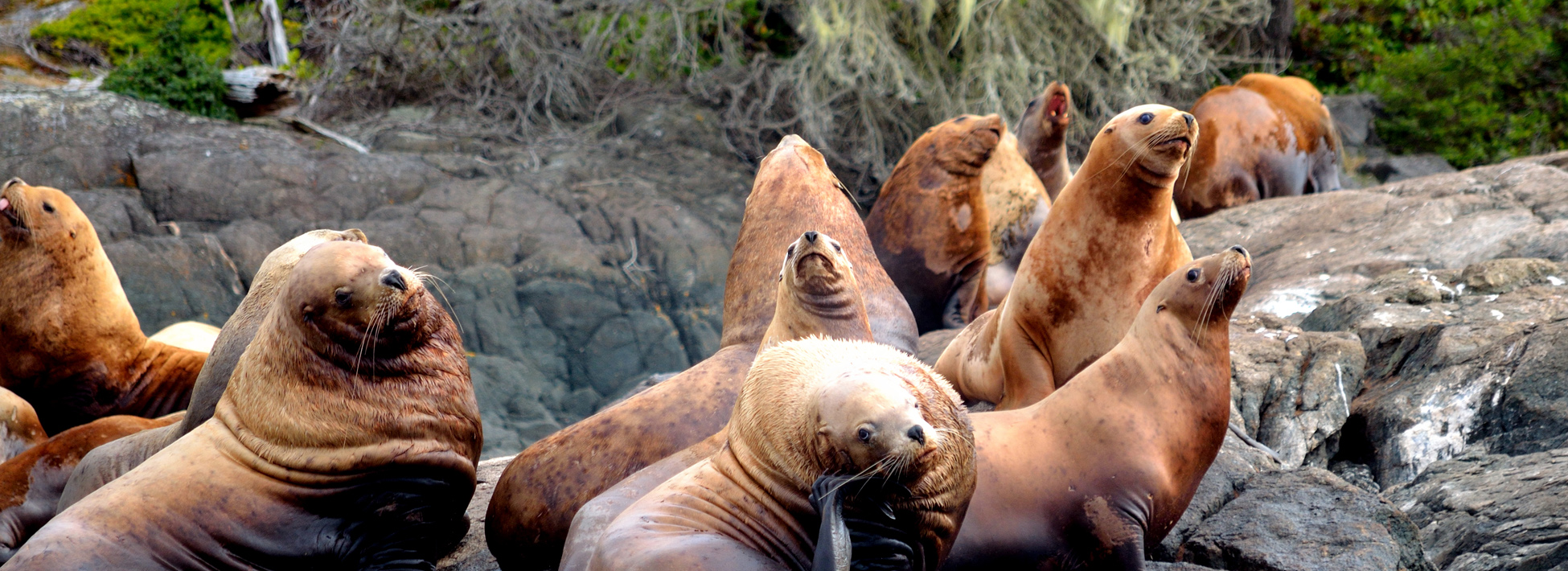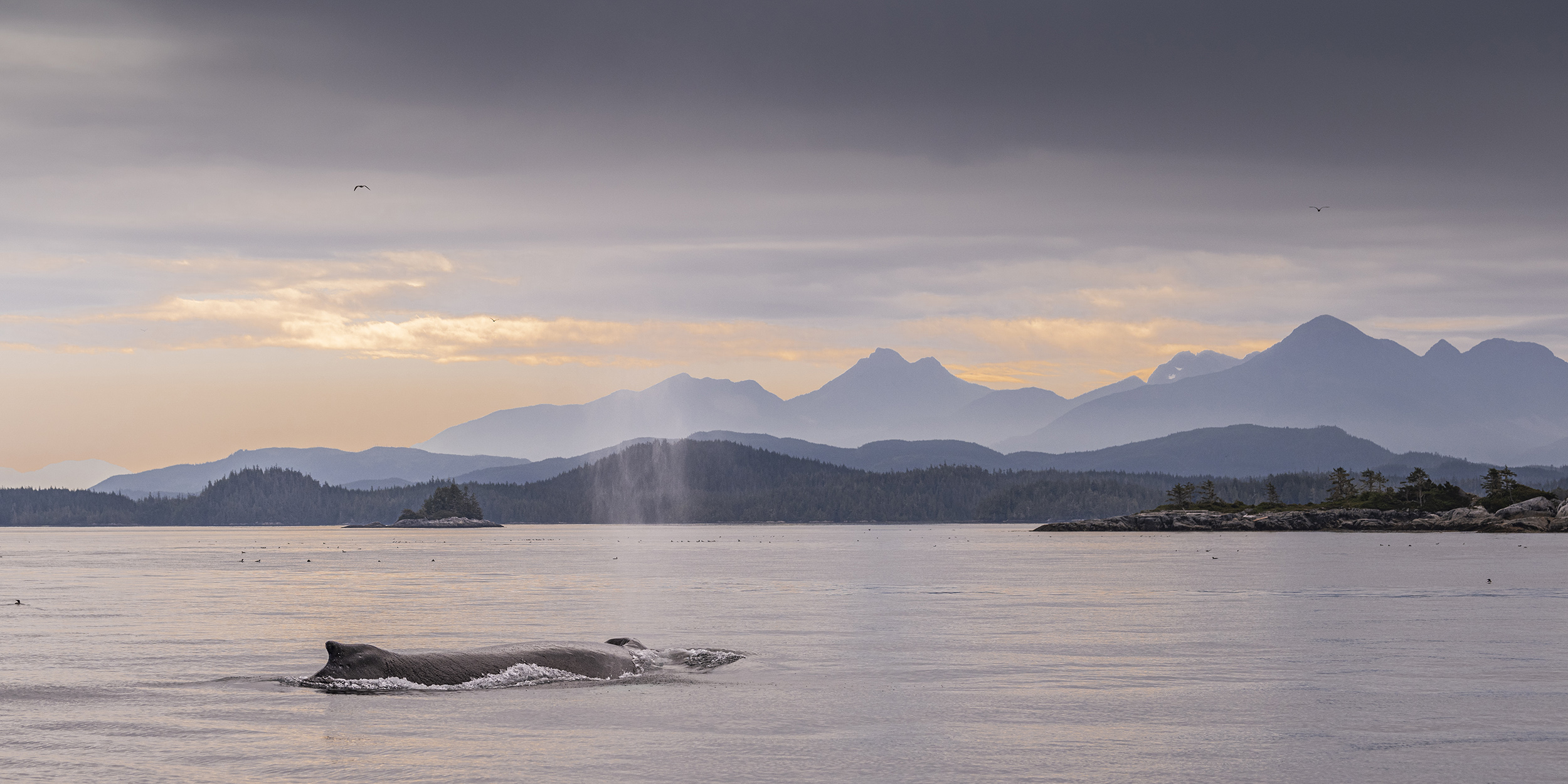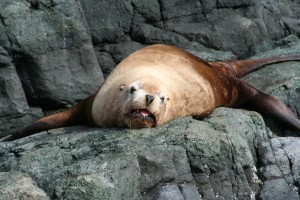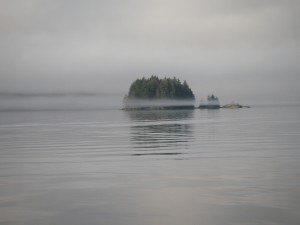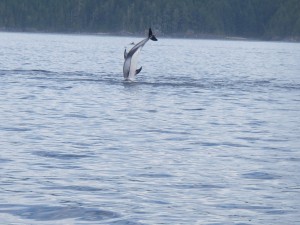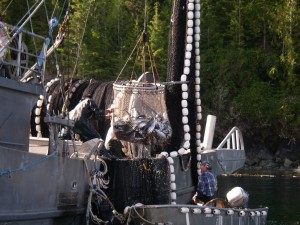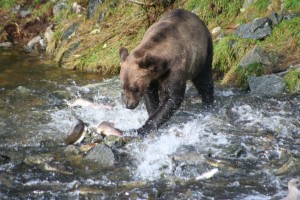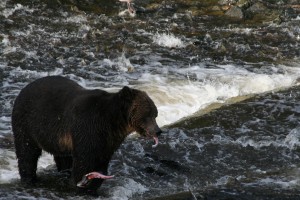Grizzly Bear and Wildlife Viewing Blog: Monthly Archives: July 2013
Sea lion resting
It appears that humans are not the only mammals that drool in their sleep. It may take a few clicks on this photo to have it enlarge but the drool is there. There are several dozen Steller sea lions that spend their summer in our viewing area and most of them are the large older males. There are several small rocky islands in the area of Telegraph Cove that provides a “haul out” for the sea lions. As long as we manage to stay “up wind” they provide a great opportunity for interesting photographs.
Photogenic island
The area we travel between the lodge on Minstrel Island and the Johnstone Strait area where we whale watch occasionally has low cloud (fog). Most days it is clear by the time we reach the Straits but if not it is gone by noon. This being the reason your guides each have a GPS with programmed routes, which made it a safe trip. These conditions do make for some interesting photography and this island is often in the pictures. I have learned over the years that the scenery in our area is considered “breath taking” by most of the guests and I still marvel at the variety of photos the guests share in the evening as they sit in the lodge’s common area.
Pacific white-side dolphin “Nose Dive”
We view pacific white-sided dolphins both in Knight Inlet on our grizzly bear tour as well as when whale watching in the area of Johnstone Straits.
Vancouver Aquarium’s AquaFacts provides the following interesting facts on their website:
“Pacific white-sided dolphins are found throughout the temperate waters of the North Pacific Ocean from Japan to North America, and from the coasts of Alaska down to Baja, Mexico.In the entire North Pacific, there are estimated to be approximately 900,000 Pacific white-sided dolphins. Dolphins travel in groups throughout their lives. In B.C., Pacific white-sided dolphins are usually encountered in groups of 10 – 100 animals, although some groups have been seen with 2,000 or more individuals.
Pacific white-sided dolphins eat herring, capelin, Pacific sardines, squid, anchovies, salmon, rockfish, pollock, hake and other small fish.Transient killer whales and sharks both eat Pacific white-sided dolphins.
When the dolphins first came back to B.C. waters, it took the killer whales a couple of years to figure out how to catch the fast-moving dolphins. Some killer whale pods drove groups of dolphins into small bays and killed them en masse but this behaviour is no longer as common, suggesting the dolphins have learned to avoid this trap.”
Grizzly family concern
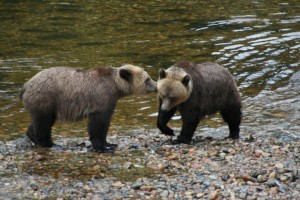
From yesterdays post a concern between mother and offspring. Family ties are strong while mother and cub are together for their first two years. It is not hard to see the family genetic in play with the colouration of these two blond-headed bears. The size difference between mother and cub mean that this will be the last year for this cub to spend with mother. It will soon be on it’s own and it will be necessary to fight for a fishing spot on the river.
Grizzly bear family in acton
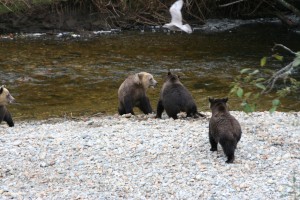 Two mothers each with two-year-old cubs try to determine fishing rights on the Glendale River. These confrontations do not lead to serious fighting as there are far to many salmon to risk injury. Unlike grizzlies in the northern parts of BC and Alaska our area has an abundance of salmon compares to the number of grizzlies. The grizzly population is estimated to be close to fifty bears in the Glendale viewing area. These bears to not exhibit the scars of old injuries as the northern bear’s bare. A little roaring and few false charges and the bears seem to be satisfied and go back to fishing. But it is still exciting and great for pictures.
Two mothers each with two-year-old cubs try to determine fishing rights on the Glendale River. These confrontations do not lead to serious fighting as there are far to many salmon to risk injury. Unlike grizzlies in the northern parts of BC and Alaska our area has an abundance of salmon compares to the number of grizzlies. The grizzly population is estimated to be close to fifty bears in the Glendale viewing area. These bears to not exhibit the scars of old injuries as the northern bear’s bare. A little roaring and few false charges and the bears seem to be satisfied and go back to fishing. But it is still exciting and great for pictures.
Purse seining
A whale-watching safari does not only include wildlife it means stopping to watch and explain all things of interest. From log booms towed by tugs to seine fishing. Seine fishing is a method of fishing that employs a seine or dragnet net. A seine is a fishing net that hangs vertically in the water with its bottom edge held down by weights and its top edge buoyed by floats. Once there are sufficient salmon in the net both ends are pulled together at the back of the boat and the bottom of the net held down by the weights is closed by pulling a draw string the same way one would close the top of a purse. Thus the name purse seining. The salmon are then bailed into the boat using a long handled net on ropes and a hydraulic wench. The nets are set and left open for about an hour but we try to watch the more interesting part of bailing the salmon this is not difficult to do as there are normally several dozen vessels fishing in the area at any one time. The time frame of this picture it was a “food fish” for the local native people of Alert Bay.
Too many salmon
This is the favourite time of the year for the grizzly bears as well as for our guests. For the grizzly because their food source is a guarantee and the biggest problem is trying to catch only the females with their fat rich eggs. For the guests because of the abundance of bears on the Glendale River’s spawning channel. After August 24th the lodge is permitted to travel up the river, by van, to the man made spawning channel and watch the bears from one of the two viewing stands. For the lodge and bears it becomes a “no brainer”; bears have unlimited salmon to catch and the lodges guests can fill their memory cards with photos.
Grizzly bear goes for salmon eggs
Grizzly bears can be selective in the parts of the salmon they choose to eat. It all depends on what time it is in the salmon run and who close to hibernation. When the salmon first arrive the bears have been maintaining their weight eating sedge grass and berries so early on grizzlies will eat the entire fish except for the intestines. As time progresses and the bears are less ravenous these less hungry bears consume only the eggs, brains and skin of the salmon, which are the fattiest parts. Near the end of the salmon run if the bear has not attained enough fat content it will return to eating the whole salmon. Also true at certain times of the season is it is common to watch grizzly bears reject the male salmon they catch for the egg rich females. In this picture one can see part of the egg sack exposed after the fat rich belly has been removed.
Excellent eagle photo
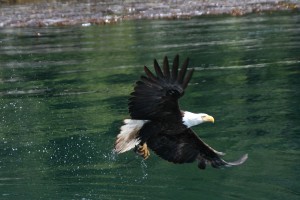 One of the guides, Glen, captures an eagle picking up a fish. You know that it is a good photo when you can zoom in on the eye and it is still sharp and in focus. Eagles are abundant in all our tour areas during the spring and summer; however the numbers decline once the salmon arrive in the local river and the eagle move for closer access to the salmon. That just means there are more eagles on the tour to the grizzly bears on the Glendale River and we have to look a little harder to locate them on a whale watching tour.
One of the guides, Glen, captures an eagle picking up a fish. You know that it is a good photo when you can zoom in on the eye and it is still sharp and in focus. Eagles are abundant in all our tour areas during the spring and summer; however the numbers decline once the salmon arrive in the local river and the eagle move for closer access to the salmon. That just means there are more eagles on the tour to the grizzly bears on the Glendale River and we have to look a little harder to locate them on a whale watching tour.
